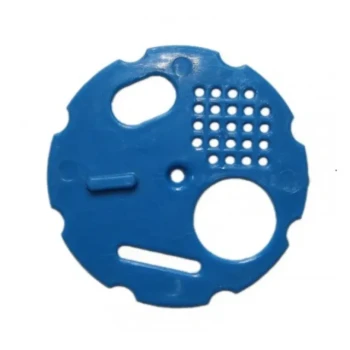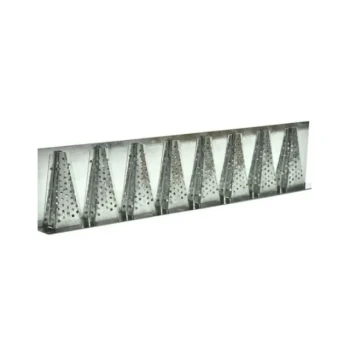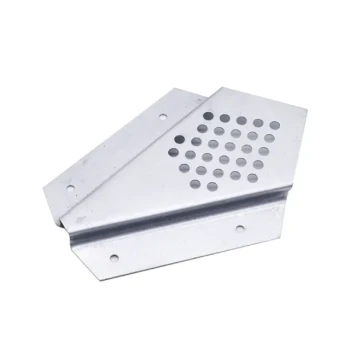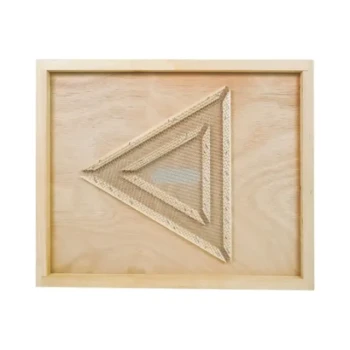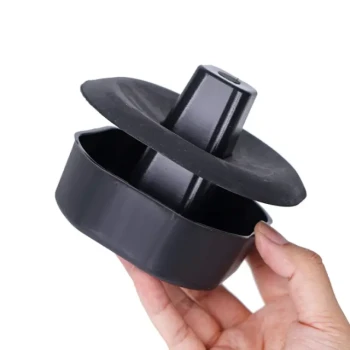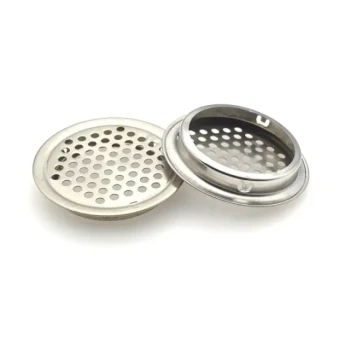At its core, the queen exclusion setting on a round beehive entrance disc is a physical barrier. It features openings large enough for worker bees to pass through but too small for the larger queen, effectively preventing her from leaving the hive. This allows the colony's foraging operations to continue uninterrupted while keeping the queen securely inside.
The function of the entrance disc's queen excluder is not just to trap the queen, but to give the beekeeper strategic control over her location. This control is fundamental to managing brood production, preventing queen loss, and ensuring a clean honey harvest.
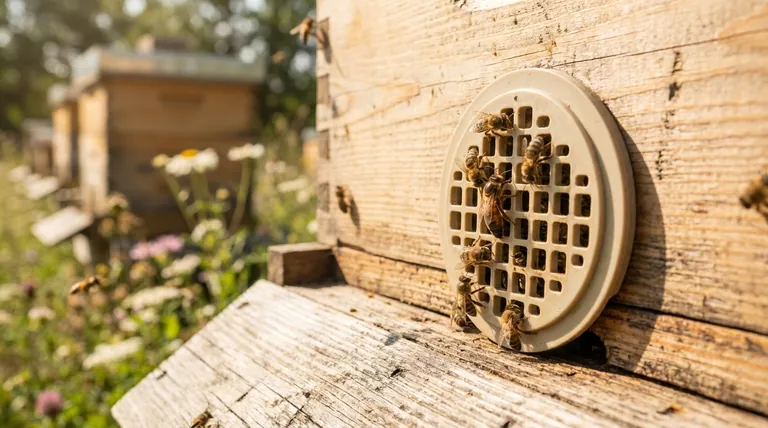
The Principle of Queen Exclusion
The entire concept of queen exclusion, whether on an entrance disc or within the hive, relies on a simple biological fact: the queen bee's thorax is larger than that of a worker bee. Beekeeping equipment uses precisely sized openings to exploit this difference.
Why Control the Queen's Movement?
The primary goal is to separate the queen's egg-laying area (the brood chamber) from the honey storage area (the honey supers). This prevents her from laying eggs in the honeycomb intended for harvest.
Keeping brood out of honey supers makes extraction cleaner and more efficient, as there is no risk of contaminating the honey with eggs or larvae. This is especially critical in commercial beekeeping operations.
Entrance Disc vs. Internal Excluder
It is crucial to distinguish between two different tools that use this principle.
The entrance disc setting is for controlling access to the entire hive. Its use is temporary and for specific situations at the main entrance.
An internal queen excluder is a flat grid placed between hive boxes. Its purpose is to confine the queen to the lower brood boxes while allowing workers to access the upper honey supers. This is the more common tool for ensuring brood-free honey.
Common Scenarios for Using the Entrance Disc Setting
The queen exclusion setting on the entrance disc is a specialized tool, not something used for daily operation. It is typically employed for short-term, specific management goals.
Preventing Queen Loss
During certain manipulations, such as a hive inspection or combining colonies, you may want to ensure the queen cannot accidentally fly away or abscond. Using this setting provides a temporary safeguard.
Aiding Swarm Management
If a beekeeper anticipates a swarm, they might use the excluder setting to temporarily prevent the old queen from leaving with the swarm. This is not a long-term solution but can buy the beekeeper time to address the underlying causes of swarming.
Securing a New Queen
When introducing a new or valuable queen to a hive, a beekeeper might use the excluder for a few days. This ensures she remains inside while she becomes accepted by the colony.
Understanding the Trade-offs
Using the queen excluder setting is not without its downsides, which is why its use should be deliberate and temporary.
Drones Are Also Trapped
The openings that block the queen will also block the larger male drones. This prevents them from leaving on mating flights and can cause congestion and distress within the hive if used for extended periods.
It Creates a Bottleneck
Restricting the entrance can slow the flow of worker bee traffic. During a heavy nectar flow, this can reduce the colony's foraging efficiency as bees get congested at the entrance.
It Doesn't Solve Root Problems
Using the excluder to stop a swarm is a temporary fix. It does not resolve the colony's impulse to swarm, which is usually driven by crowding or other factors that the beekeeper must address directly.
Making the Right Choice for Your Goal
Selecting the correct entrance disc setting depends entirely on your immediate objective for the colony.
- If your primary focus is daily foraging: Use the largest, fully open setting to maximize traffic flow and ventilation.
- If your primary focus is brood-free honey supers: Use an internal queen excluder between the brood box and honey super, not the entrance disc setting.
- If your primary focus is short-term queen containment: The queen exclusion setting on the entrance disc is the correct tool for preventing her exit during a specific event.
- If your primary focus is securing the hive for transport: The "closed with ventilation" setting is often the best choice, as it secures all bees while allowing critical airflow.
Ultimately, mastering the entrance disc is about understanding it as one of several tools to manage your colony's health and productivity effectively.
Summary Table:
| Function | Benefit | Key Consideration |
|---|---|---|
| Prevent Queen Loss | Secures queen during hive inspections or manipulations. | Temporary use only to avoid colony stress. |
| Aid Swarm Management | Temporarily stops the old queen from leaving with a swarm. | Does not solve the root cause of swarming. |
| Secure a New Queen | Ensures a newly introduced queen remains in the hive. | Ideal for a short period during queen introduction. |
| Trade-off: Drone Blocking | - | Also traps drones, which can cause congestion. |
| Trade-off: Entrance Bottleneck | - | Can slow foraging traffic during a heavy nectar flow. |
Optimize your hive management with the right equipment from HONESTBEE.
As a trusted supplier of beekeeping supplies and equipment for commercial apiaries and distributors, we understand the critical need for precision tools like queen excluders. Our high-quality entrance discs and internal excluders are designed for durability and effectiveness, helping you maximize honey production and maintain colony health.
Let our expertise support your operation. Contact HONESTBEE today to discuss your wholesale needs and discover how our equipment can enhance your productivity.
Visual Guide
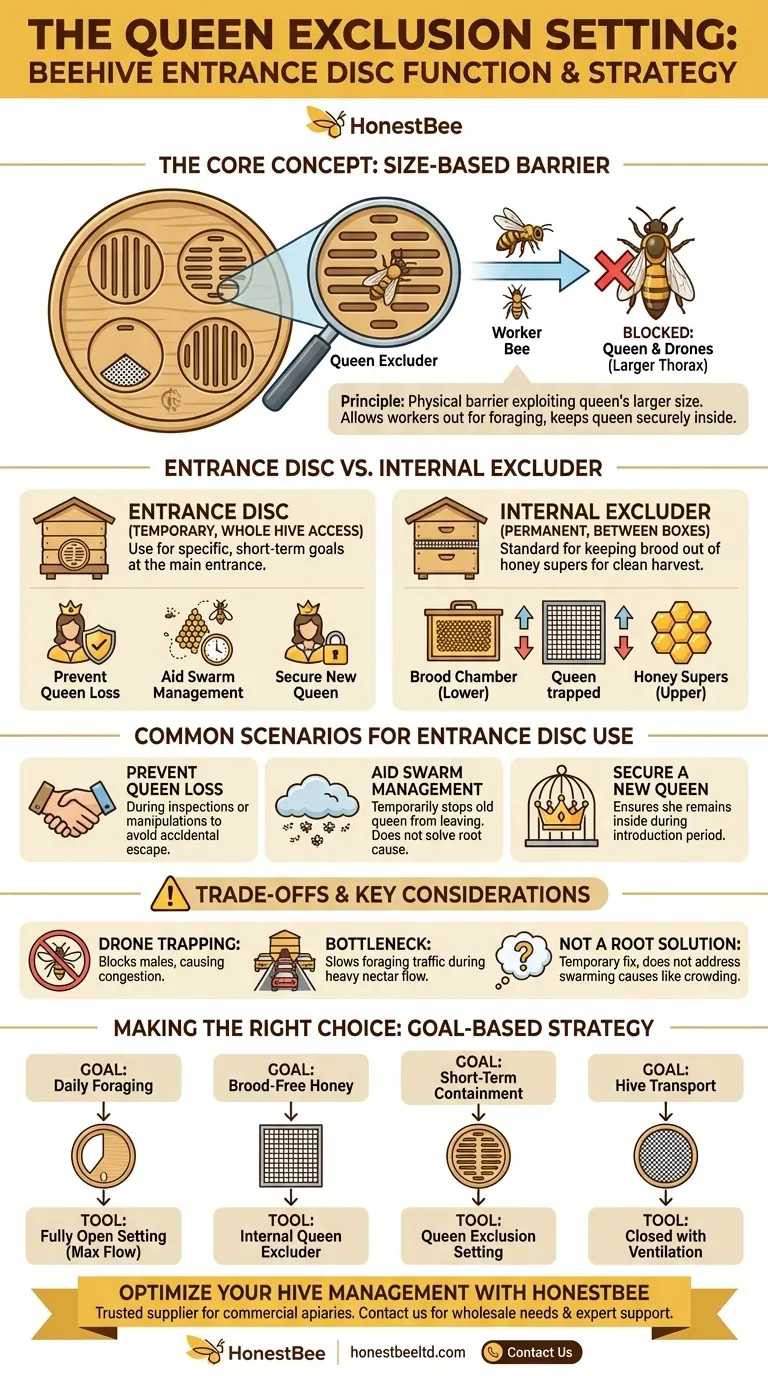
Related Products
- Professional Plastic Queen Excluder for Modern Beekeeping
- Wooden Queen Bee Excluder for Beekeeping
- High Performance Plastic Queen Excluder for Beekeeping and Apiary Management
- Metal Queen Bee Excluder for Beekeeping
- Multi-Functional Sliding Hive Entrance for Beekeeping
People Also Ask
- What are the pros of using queen excluders? Boost Honey Production & Hive Efficiency
- How does a queen excluder work? Master Hive Management for Pure Honey Harvests
- What is the role of a queen excluder when adding a super? Ensure Brood-Free Honey Harvests
- What is the purpose of a queen excluder when adding a super? Streamline Your Honey Harvest
- What is the primary function of a queen excluder in beekeeping? Control Hive Layout for Efficient Honey Harvesting






